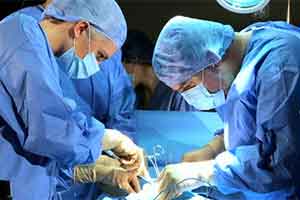Study Allays Concerns that Cardiothoracic Physicians-In-Training Provide Suboptimal Care
Similar Outcomes Seen When CABG Performed by Supervised Residents or Attending Physicians, According to Presentation at 95th AATS Annual Meeting
 When educating medical students or residents to perform highly technical procedures, there is always a challenge to balance the educational mission with maintaining quality results and optimal patient care. This report compared outcomes of cardiac surgery residents to those of attending physicians in performing coronary artery bypass grafting. It found no differences in patient outcomes or graft patency between the residents and attending surgeons.
When educating medical students or residents to perform highly technical procedures, there is always a challenge to balance the educational mission with maintaining quality results and optimal patient care. This report compared outcomes of cardiac surgery residents to those of attending physicians in performing coronary artery bypass grafting. It found no differences in patient outcomes or graft patency between the residents and attending surgeons.
A conundrum in medical education is how to train residents in complex and technically difficult procedures without reducing the quality of patient care. In an analysis of prospective data from a study of coronary artery bypass grafting (CABG), no differences were found in short-term or one-year patient outcomes and patency of grafts between properly-supervised residents and attending surgeons.
“These findings strongly support the education and training of residents who will be the future generation of cardiac surgeons,” stated Dr. Almassi, a professor of cardiothoracic surgery at the Medical College of Wisconsin (Milwaukee).
This was an analysis of prospectively collected data from the ROOBY (Randomized On/Off Bypass) trial, the world’s first large trial that was designed to compare outcomes from standard CABG with the use of a heart-lung machine to the beating heart bypass grafting technique. Eighteen Veterans Affairs (VA) medical centers took part in the study and 2203 patients were enrolled. Most of the medical centers were affiliated with academic medical schools and 16 participated in the training and education of both medical students and cardiac surgery residents.
The level of residents’ training varied between postgraduate year 6 and 10 postgraduate year. The results showed that residents acted as the primary surgeon in the majority of surgeries: 77.8% (493/633) of on-pump CABG procedures and 67.4% (431/639) of off-pump procedures. This difference was statistically significant (p<.001). This corresponded to 79.2% and 67.3% of the distal coronary anastomoses in the on-pump group and off-pump groups, respectively (p=0.013). There were no differences in patient characteristics between those operated on by the residents compared to those operated on by the surgical attending physicians.
No differences between surgeon groups were found in short-term perioperative morbidity (e.g. myocardial infarction, reoperation for bleeding, stroke, new mechanical circulatory support, reintubation, prolonged ventilator support, mediastinitis or renal failure) or mortality. For example, the operative death rate was 0.9% for both residents and attendings. At one year following surgery, the rate of repeat revascularization was 4.4% for the residents and 4.3% for attendings. Rates for other major adverse cardiac events (MACE, including all-cause death, non-fatal myocardial infarction)) and graft patency were also similar for the two groups.
“Concerns about the outcomes of surgeries performed by physicians-in-training are heightened by the establishment of integrated thoracic surgery training programs,” explained Dr. Almassi. In these six-year programs, residents do not have the surgical training afforded by the traditional four or five years of general surgery prior to beginning cardiothoracic surgery training.” Nevertheless, Dr. Almassi commented that with appropriate case selection and supervision, ROOBY documents that residents performed CABG with similar outcomes to attending surgeons.
Source: American Association for Thoracic Surgery (AATS)

